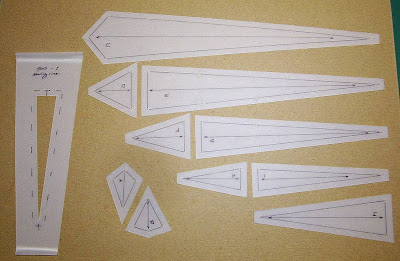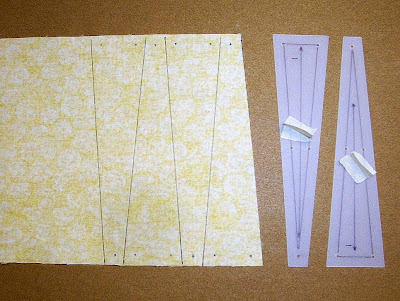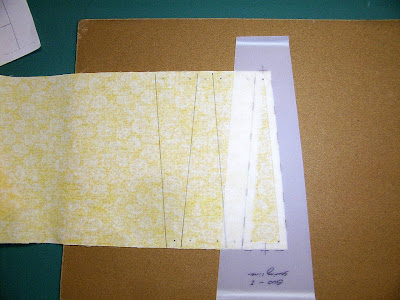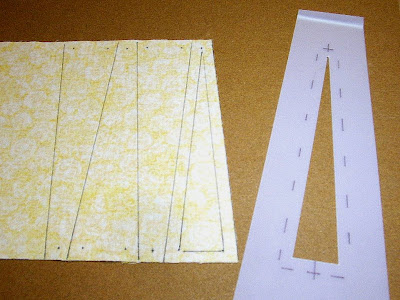

Crispy commented on this sunflower, which was shown in my first post. She also asked how I planned to press the seam allowances on those sharp points at the tips of my current block, the compass, so that the seams went under the yellow patches, as I said I was going to (sharp gal!) Interestingly, I can illustrate this little problem with the compass by showing how I handled the same issue in the sunflower block.
The second photo above shows the back of the sunflower block. (Brown thread! I would have used white on the outer petals if I were doing it now.) Notice the tips of the petals. I have pressed the seam allowances under the petal patches. I did this so the petals would appear to stand out, especially if I planned to quilt around their edges "in the ditch". Also, the background fabric is rather thin, so the seam allowances would have shown somewhat if I had pressed any of them them toward the background instead. So in this case I elected to press the seam allowances toward the petals, even though right at the tip it gets a bit bulky. Can you see that?
I accomplished this by pressing the seam allowance under on one side of the petal, and then, when I folded the other side under, the bulk at the tip is folded back on itself. This fabric is thin, as I said, so it really isn't much of a problem. I don't plan to quilt through that bulk (I could trim it a bit at the very tip if it was going to prevent me from quilting close to the petals there), and it lies flat enough.
But what if the fabric had been bulkier? Like the fabric I used in my compass. And what if those petals were long and skinny, like the sharp points of the compass? Then I might make another decision. You can see from the next photo, of the back of my compass, that the seam allowances are quite cooperative except at the outer edge of the block. There, they stand straight up! (By the way, this block section has not been pressed with an iron yet. Only finger-pressed. I do not want to distort the fabric, and I also like to see the natural behavior of the seams. Forcing them to go in a contrary direction is a last resort.)

(Click on the photo to see it larger. Then use your browser's Back button to return to the blog.)
What are my choices here? I chose these bulky fabrics because they were the best I had on hand for this project. The background is Kona Natural (this is not like the stiff Kona solids, which I do not like to hand piece with), and it is bulky and soft, like a thick muslin. The yellow is also a "beefy" fabric. I selected these two fabrics because I liked the yellow, and the Natural was the only thing I had on hand that would work well with it. I knew the seam allowances might give me some trouble, but I had the confidence that I would be able to find a way to handle them when the time came. As I piece the block, I consider the options.
The options I can think of are: 1) Press the seam allowances away from the yellow instead; 2) Press the seam allowances all in the same direction; 3) Press the seam allowances toward the yellow, folding them as I did in the sunflower block; 4) Plan to use a batting with a bit of loft and simply let the seam allowances sink down into it, going in whichever direction they like, then use a quilting pattern that would avoid them; 5) Clip the allowances somewhere so part could go out and part in (if you follow); and 6) ???
Have I missed any options? One thing I know for sure, I will find a good way to do it. The point is, every block is different not only in its design but also in the qualities of the fabric, the quilting pattern you plan to use, the batting you plan to use, and other ways. I just want to point out that I don't have all the answers when I begin. I consider what I can, and anticipate what problems I can in order to make the whole experience pleasant, but I can't figure it all out ahead of time. However, I can apply my experience with past projects to the new block whenever I get to a point of decision. Having considered the same issues in the past helps me make the best choices for the current block.
I am sharing this with you now to help you make these decisions, too. I want to point out (though I know many of you know this well already) that it is never "one size fits all", that these picky things are worth considering, that there are a lot of considerations as well as a lot of options, and that past experience helps with decision making. I am only interested in piecing fun blocks! The piecing experience must be enjoyable. I suppose I work rather hard to make it so, but I enjoy that process, too :-)


















 I finally decided on a simple yellow and white scheme. I had once seen an antique quilt with these colors, and the compasses looked so sunny and cheerful!
I finally decided on a simple yellow and white scheme. I had once seen an antique quilt with these colors, and the compasses looked so sunny and cheerful!





